This will be the first of four official videos on the Lamborghini Countach.
It has been 50 years since the legendary Lamborghini Countach first appeared at the Geneva Motor Show. Very few supercars have had such a lasting impression as the Countach, and to this day Lamborghini has yet to capture the public’s attention in quite the same way as it did back then.
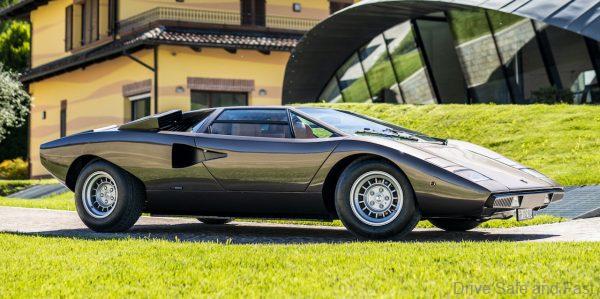
To commemorate this truly important supercar, Lamborghini is releasing 4 videos on it. The first involves the Countach’s original designer, Marcello Gandini. He talks us through his philosophy when penning the Countach and gives us some context for its place in that era. Check out the video below.
And here’s the press release and some photos too.

PRESS RELEASE
In its celebration of the 50th anniversary of the Countach, Automobili Lamborghini is launching a series of four videos on its social media channels. Every Monday they will recount the legacy of an automotive icon in an unprecedented manner, by involving inspirational personalities. The first is Marcello Gandini, the designer behind the futuristic lines of this super car, created in a unique era when the stylistic and technical freedom of designers of those days was all but absolute, with very few regulatory and statutory restrictions.
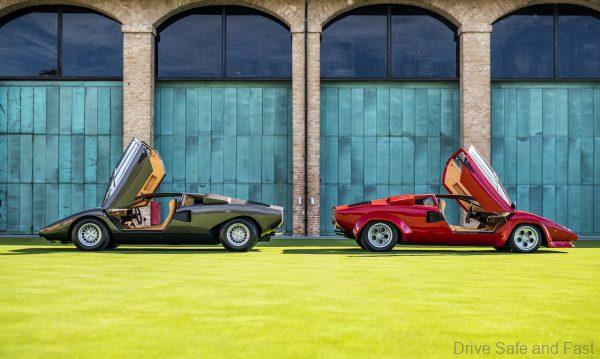
That period of the 1970s was one of ultimate creativity, one of the most important moments for design. These years shaped important social conquests, from the space race and the advent of high tech with the construction of modern computers, to the geometric pattern fashion trends with their explosion of bright colors and the advent of individualism and the jet age. Ending up on the walls of the bedrooms of an entire generation and playing a major role in dozens of films, the Countach depicted much more than a clamorous, commercial success. While still in production, it was able to play the role of a style and performance icon by rightfully winning space in the annals of world automotive history.
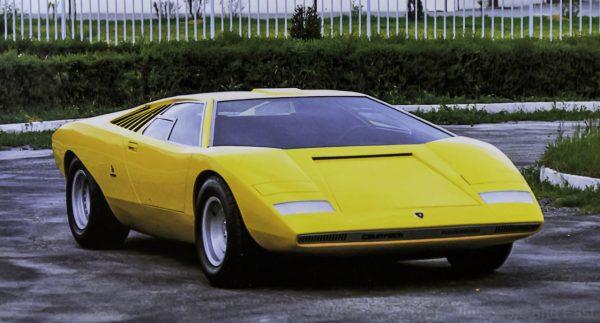
1971: the debut with the “idea car”, the Countach LP 500
In the summer of 1970, Ferruccio Lamborghini pushed his men to get a revolutionary car that could succeed in the not so easy undertaking of replacing an icon like the Miura. The new car had to be technically advanced and faster, able to become the sports car symbolizing the 1970s. The 12-cylinder engine remained but its displacement was increased from 4 to 5 liters, and its position on the car changed: from rear transversal to rear longitudinal. To be able to achieve this while avoiding the limitations of a rear overhang transmission, the company’s technical manager, Paolo Stanzani, invented a new technical solution, with the transmission placed in front of the engine, practically abutting the seats, and the propeller shaft passing inside the engine block. From the stylistic viewpoint, Marcello Gandini, head of style at Carrozzeria Bertone, decided to abandon the rounded shapes that had distinguished the 1960s and he designed a very low and wide car featuring sharp edges. It was absolutely extraordinary in its shape.
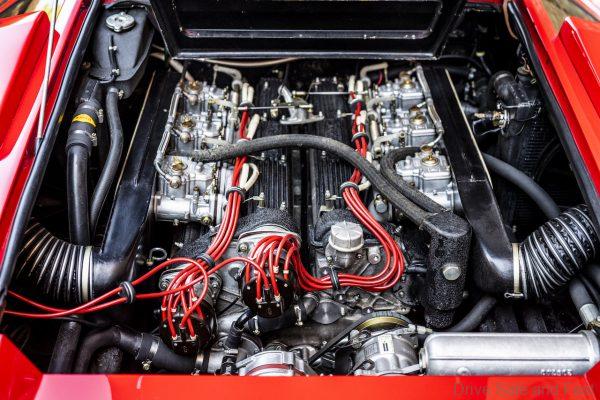
Gandini decided to use scissor doors not only to fulfill a technical requirement resulting from the height of the side portion of the chassis but also to gain a few centimeters in width to make it easier to climb into the car. By opting for this solution, he met with Ferruccio’s approval for another innovation and, even if he wasn’t yet aware of it, he created what has since become one of the most distinctive features of all the 12-cylinder models produced in Sant’Agata Bolognese. The extraordinary feature of the LP 500 lies in its sharp edges, which in the automotive industry became the stylistic symbol of the years to come, and gave birth to a model that remained in production with very few modifications for seventeen years.
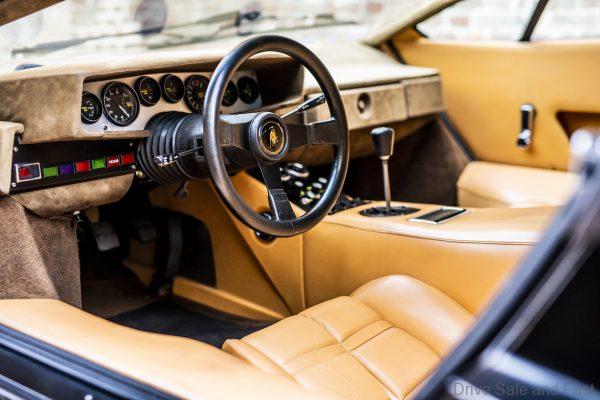
It was precisely while working on the execution of this first prototype, called LP 500, which had to be ready for the Geneva Motor Show in March 1971, that the word “Countach” made its first appearance. It is an exclamation of the Italian Piedmontese dialect that indicates astonishment and admiration for something.
1973: the first generation, the Countach LP 400, was born
The Countach LP 500 was an instant and total success. However, the Countach was not ready. It was an “idea car” designed to test people’s reactions. When it was decided to begin development, it was put into production as soon as possible. Roughly two years of intensive work stretching over long days on the road, driven by the legendary New Zealander test driver Bob Wallace, were needed for the Countach LP 500 prototype to become a standard production car. It was also exhibited at the 1971 Paris and Turin motor shows. A considerable number of modifications became necessary, especially linked to engine cooling and the air inlet into the engine compartment. This was why two Naca side air intakes and two ducts were added above the radiator’s air intakes. The shape of the nose changed slightly by being raised a couple of centimeters.
Following the early road tests, the 5-liter engine proved to be still too immature and delicate, so it was replaced with a 4-liter engine. The Countach LP 400 made its official debut at the Geneva Motor Show in March 1973 with the chassis #1120001 car. It was a prototype very similar in its entirety to the one that was to then be the standard production car. Compared to the Countach LP 500, the LP 400 differs from a technical point of view, primarily by adopting a tubular trellis frame instead of a self-supporting structure. The body was made with aluminum, no longer steel panels, and it underwent all the aesthetic and technical modifications that were found necessary during its development. The car, presented in Geneva in the color red, was later exhibited repainted medium green at the 1973 IAA motor shows in Frankfurt, Paris and Earls Court London. Sold in Switzerland, it was relocated in the early 2000s and today is owned by Automobili Lamborghini and on display at the company museum, the MUDETEC.

The standard production Countach had a differentiated diameter tubular steel frame, and was completed by a fiberglass flat base and sheet metal panels to “close” the engine and luggage compartments. Extremely rigid, it offered a number of benefits also in terms of mass, and was kept practically unaltered throughout all its years of production.
The 4-liter (3929 cc) engine, powered by six Weber 45 DCOE twin-body carburetors, developed 375 hp at 8000 rpm to reach a top speed close to 300 km/h. The suspension was derived from that of race cars, with triangles of different lengths, coil springs, hydraulic shock absorbers and stabilizer bar at the front axle and, at the rear axle, upper trapeziums and lower triangles, with adjustable double shock absorber for each wheel, and anti-roll bar. Its brakes were the disk type, self-ventilating and fitted with a new type of caliper designed for racing. Considered by many to be the purest version of Marcello Gandini’s design, the LP 400, with 152 series units produced up until 1977, is today the most sought-after version by collectors.
1978: the Countach LP 400 S
The LP 400 was replaced by the Countach LP 400 S starting from 1978. It sported the new Pirelli P7 tires, which were lowered extensively and mounted on newly designed magnesium rims, 205/50 VR 15 on the front and 345/35 VR on the rear. It featured wheel arch extensions necessary to contain the larger tires, an ultra-low front spoiler and, as an option, a rear wing that was also to become one of the most distinctive features of the Countach in the following years. To this day, the LP 400 S is still considered the perfect example of the DNA of the Countach and Lamborghini, made of sportiness, alluring shapes and futuristic technology. Never before had a “normal” car with such a racing appearance been seen on the road, and it was the source of inspiration for each one of the subsequent Countach series. 235 units of the LP 400 S were built until 1982, when the LP 5000 S was introduced.
1982: the Countach LP 5000 S
The first thing that engineer Giulio Alfieri, who joined the company in 1979 as Technical and Production Manager, and later General Manager, created was the (almost) 5-liter engine that was fitted on the LP 5000 S, officially presented at the Geneva Motor Show in March 1982.
Aesthetically unrecognizable compared to the LP 400 S, it had a slightly revised interior. The new engine developed 375 hp at 7000 rpm, with a 41.8 kgm torque at 4500 rpm, and it retained the six Weber 45 DCOE horizontal twin-body carburetors (after being imported into the USA, some vehicles were fitted with the Bosch K-Jetronic electronic injection). 323 units were produced until 1985 when the LP 5000 Quattrovalvole was revealed at the Geneva Motor Show in March 1985. It was also the first version to be officially imported and type-approved in the USA, as well.
1985: the Countach LP 5000 Quattrovalvole
The Quattrovalvole adopted a new evolution of the 12-cylinder engine, with displacement increased to 5.2 liters and equipped with a head having four valves per cylinder. The new technical solution demanded that new carburetors be used, six Weber DCNF, and no longer in the horizontal position but mounted vertically. The version for the US market, on the other hand, had Bosch KE-Jetronic electronic injection combined with catalytic converter and recovery of the gas fumes. The boosted power was amazing: 455 hp at 7000 rpm. The front track was increased by 4.4 millimeters and aesthetic alterations were minimum: a new engine hood featuring a larger protuberance necessary to contain the new vertical carburetors.
The QV in 1988 was also given side skirts that made its appearance even more modern. The US version is recognizable not only by its side repeaters, but also by its bumper profile applied to the rear panel and its oversized front bumper. The QV was the first standard production Lamborghini to use composite material, in this case for the engine hood. A total of 631 Quattrovalvole models were produced up until 1988.
Ever since the beginning of the Countach’s production, some cars were sold on the US market, but until Model Year 1986, with the arrival of the LP 5000 Quattrovalvole, the Countach had not been officially type-approved for that market.
Every Countach found in the US had its own personal import history and received a number of modifications necessary to pass the strict US regulations in terms of pollution and protection against parking impacts. These were in any case impromptu solutions that heavily limited the possibility to sell a Countach on one of the world’s most important markets. It is not by chance that the annual Countach production was to set its records precisely towards the end, with almost 50% of its total production in the last four years, from 1987 to 1990, when the model was more than fifteen years old.

1988: the Countach 25th Anniversary
The Countach 25th Anniversary, the last evolution of the Countach project, debuted at the Paris Motor Show in September 1988. Actually, the need to replace the Countach was anticipated as far back as 1985, when engineer Luigi Marmiroli took the place of Giulio Alfieri at the helm of the Automobili Lamborghini Technical Office. It had been in production for over fourteen years, but in the meantime it was decided to freshen up the Countach with a new version that was to be named 25th Anniversary, to celebrate the company’s 25-year history.
The aesthetic updates were significant, while those of the mechanics and chassis were minor. The engine was given an improved cooling system and the chassis was adjusted in a different manner to better adapt to the new Pirelli P Zero tires. The passenger compartment was revised and made more comfortable thanks to seats with less bolster that were electrically adjustable and electric windows. The body style was decisively revised by young Horacio Pagani, who was working for Lamborghini at the time. He rounded the shapes and better integrated the external appendages, such as the wheel arch extensions and the plates under the doors. In addition to the new modular aluminum rims, visible features of the 25th Anniversary are the air intakes positioned in the rear, made rounder and longer to also contain the hot air outlet. These modifications, some of which borrowed directly from the Countach Evoluzione prototype, made the 25th Anniversary the Countach with the most superb results in terms of aerodynamic downforce and penetration.
The 25th Anniversary exhibited a substantial difference between the “US” version, equipped with electronic injection, and the rest of the world, which was still equipped with carburetors. The very last Countach, a 25th Anniversary, was produced on July 4, 1990 with Europe specification. Its exterior was Argento Metallizzato (metallic silver) and had a Gray leather interior. This Countach was car number 658 of the 25th Anniversary series, the most produced in Countach history, and carried the total production number of the Countach model to 1999 cars (without including the first LP 400). It has not been sold, and is still on display at the MUDETEC.

